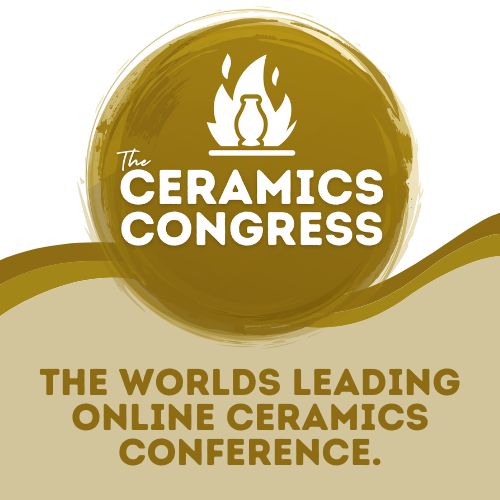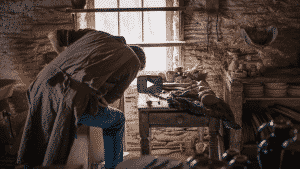Today, we are pleased to continue our exciting travel-focused series “Ceramic Cities”, this time visiting the one and only City of Love, Paris!
While Paris may be best known for its high fashion and romantic atmosphere, it also has a wealth of ceramic treasures to explore as well, both in and outside of the museums. If you’re a ceramic artist with a love of exploration, top up your handmade demi tasse with some espresso, and join us on our grand ceramics tour of Paris!
1. The Musée des Arts Décoratifs
Rue de Rivoli
Admission: 22.00 € (~$24 USD)
Housed in the Rohan and Marsan wings of the Louvre, the Musée des Arts Décoratifs aims “to keep alive the culture of the arts in France which seek to make useful things beautiful.” With one of the world’s largest decorative arts collections (roughly 531,459 pieces) it certainly does just that! Of particular interest to the ceramic artist may be the Art Nouveau and Art Deco collections with their ornate use of ceramics, but you’ll find plenty of ceramics throughout the museum, as well as in its temporary exhibitions. If you are looking for a ceramics-rich museum experience, this is your first stop.
2. Viaduc des Arts
Ave Daumesnil, 12th Arrondissement
Located in the former Bastille viaduct, Viaduc des Arts has been in operation since 1990 and features 61 vaults that are home to over 40 artisans. The quality and diversity of the crafts represented is impressive, from feather workers, glass blowers, and shoemakers, to luthiers, cabinet makers, and – of course – ceramicists. Current ceramic residents include Wecandoo, which hosts a variety of pottery workshops, as well as Rairies Montrieux, which makes architectural bricks and terracotta tiles using artisanal processes. If you are a ceramics lover who also can’t get enough of other craft processes, the Viaduc is sure to satisfy!
3. La Tuile à Loup
Rue Daubenton, 5th Arrondissement
By Appointment Only
Opening its doors in 1974, this ceramics boutique in the Quartier Latin is a pottery lover’s paradise, with handmade works from all regions of the country. La Tuile à Loup prides itself on showcasing works that not only feature strong technical know-how, but a clear emotional and soulful presence as well. This translates into a finely curated selection of ceramics that encourages connection and a desire for use. We’re sure you’ll have a hard time walking away without at least one new treasure for your home!
4. Sèvres – Manufacture and National Museum
Sèvres
Admission: Full rate: €7 (~$7.65 USD) Reduced rate: €5 (~$5.50 USD)
Located between Paris and Versailles, Sèvres has been synonymous with porcelain since the 18th century, and with a visit to its factory and museum, you will quickly see why. The Manufacture Nationale de Sèvres (originally Vincennes Porcelain) opened its doors in 1756 and has been owned by the French crown or government since 1759. With stylistic beginnings in neoclassicism, Sèvres production continuously evolved with the times (and with the tastes of various French rulers), and today it is still renowned for its high quality porcelain.
With a history nearly as long as the factory, the 200 year old National Ceramics Museum houses a world-renowned collection of nearly 50,000 works selected to present the most varied examples of ceramics from around the world and across the ages. Intended to serve as inspiration to the Manufacture’s artisans and artists, while also serving researchers, manufacturers, and scientists, the collection now delights the general public as well. So whether you are already a lover of European ceramic history, or are learning about it for the first time, a visit here is sure to give you a porcelain experience you won’t forget!
5. Art Nouveau Architecture
7th and 16th Arrondissement
If you are looking to take a break from the museums to enjoy the beauty of the Parisian streets, a tour of the city’s Art Nouveau architecture is a great way to take in some ceramics at the same time. Popular between 1890 and 1910 during the Belle Époque period, Art Nouveau was an international style that took particular hold in Paris, and is easily recognized for its use of organic lines, sense of movement, and asymmetry. Clay was a favored material by artists of the movement, and you will easily be captivated by its use in ornate building facades and interiors. To get you started, consider visiting the Cafe Prunier, with its vibrant mosaic, or the Hotel Elysees Ceramic, which is particularly known for its clay features. Also noteworthy are the Restaurant Bon with its glazed bricks and plant mosaics, and The Lavirotte Building which features tiles by the famous ceramics manufacturer Alexandre Bigot.
Whether you choose a guided tour or venture out on your own, you’ll quickly fall in love with the playful and elegant use of ceramics on the facades of many of these iconic buildings!
From beautifully curated ceramic shops to historic factories and modern studios, we are sure we’ve found some exciting ceramic destinations to add to your next visit to La Belle Paris!
We know the city has even more clay-focused treasures to reveal than what we could cover here, so if you have a favorite that we missed, be sure to add it in the comments below!
And if you’re joining Ceramic Cities for the first time, why not check out the rest of the series, where we reveal some must-see ceramics in London, Toronto, and New York City!






Responses